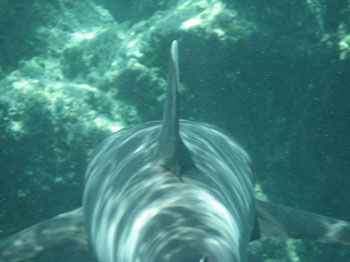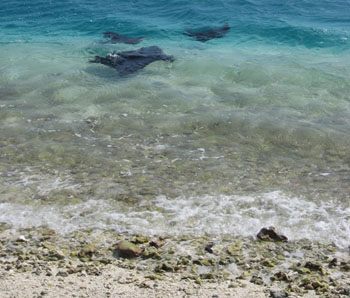|
You
are here: /main/research
expeditions/June-July
2006/ Day 27
Tips and Rays – Elasmobranchs at Pearl and Hermes Atoll
By Paulo Maurin, University of Hawaii and
Ellyn Tong, Hawai`i Audubon Society
Pearl and Hermes Atoll gave us a close look at a family of fishes called Elasmobranchs. Elasmobranchs are
sharklike fishes with cartilaginous skeletons; their family includes sharks, rays, chimaeras, and skates.
They are often thought to be primitive fishes, but they are highly derived and specialized. At Pearl and
Hermes we were able to witness some interesting behaviors of both spotted eagle rays and white tip reef
sharks.

Paulo checking the shark hole, head first in the Hawaiian Islands National Wildlife Refuge. Photo: Ellyn Tong
Just ten yards from the beach in water three feet deep was a coralline shelf with a hole about seven feet
in diameter. When I popped my head into that hole for a closer view, I was impressed to see seven white
tip sharks resting closely together on the bottom. White tips are small sharks which reach a maximum
length of five feet. The species is often described as harmless to people. They have a diet of animals
found at the bottom of shallow waters, such as octopus and fish.
For the most part, Elasmobranchs are large predators, often exceeding 1 meter in length. Among the most
important unique characteristics is that they lack calcified bones. Instead, they possess a cartilaginous
skeleton, the same semi-rigid material found in our ears and nose. Their teeth are replaced serially, a
trait that is rare among bony fishes (and, unfortunately, among humans too.)
Bony fishes control their depth by making constant adjustments to their gas bladder. Sharks and rays took
a completely different evolutionary route. Elasmobranchs lack a gas bladder that fish use for buoyancy.
Instead, they use their large, oil-rich liver to control their buoyancy. With this incompressible oil,
sharks and rays can rapidly change depth, and this allows them a greater range to chase prey and exploit
different habitats. This in addition to a low-drag skin and low metabolic rates, allows them to be one of
the ocean’s outmost energy savers. Pound by pound, the energy needs of sharks and rays are much lower than
many other fishes.
Being efficient users of energy means that sharks do not have to eat a whole lot. No species of sharks
prey upon us. In fact, most shark attacks are rare cases of mistaken identity. Yet they are strong
contenders for the most misunderstood species in the public mind. They bear the brunt of our misconception
about the natural world and they strike fear like few other species do.

The backview of a white tip shark, showing some curiosity towards us.
Photo: Paulo Maurin
Sharks are becoming an increasingly rare sight around the world’s oceans. Their
numbers have been declining at alarming rates. In over four years of ocean activities
in the Main Hawaiian Islands, one of the co-authors
of this article has seen only a single shark. Most people can do hundreds of
dives, yet never see one of these great predators. Most sharks reproduce very
slowly. Some sharks need to be at least seven years old
to reproduce and when they do, they reproduce fewer than a hundred young. Globally
they are being killed for their fins, which Chinese restaurants make into shark
fin soup. When a shark is finned, only 8% of its
body---its fins--are kept, and its carcass is discarded. Sharks are important
in the Hawaiian culture and they are an important component in the reef ecosystem
by dutifully eating weak or diseased fishes and
keeping populations healthy.
While we were walking along the beach to the site where we would ultimately see
the white tip reef sharks, we noticed several large fins flopping out of
the water about ten yards offshore. Upon closer inspection,
we noticed one large, 5-foot dark gray body, with two smaller gray bodies chasing
it. This parade of bodies was swimming in tight circles, with seemingly
little care as to where it was going. We had happened
upon the spotted eagle ray mating dance.

Three Eagle Rays can be seen at the “toilet bowl” off Southeast Island Hawaiian Islands National Wildlife Refuge, with their wings coming out of the water. Photo: Paulo Maurin
Spotted eagle rays are different from stingrays, because they have a large, prominent head. It also has a
large, muscular snout. The spotted eagle ray feeds on bivalves and other mollusks by digging in the sand
with its muscular lower jaw. Its teeth are fused together to form a grinding plate. Is has a venomous
spine on its tail. We swam with the larger ray after swimming with the sharks and she appeared to be
really fat, and possibly pregnant. Litters of the spotted eagle ray number from six to ten young.
In her twenty years of scuba diving in the Main Hawaiian Islands, the other co-author has probably seen a
spotted eagle ray fewer than ten times, and a shark fewer than a dozen times. Seeing both spotted eagle
rays and white tip reef sharks in large numbers at once and in the same place, demonstrates how special
the Northwestern Hawaiian Islands are. It is a sanctuary for the cartilaginous ones, who are globally
overfished, misunderstood, and rarely seen.
|